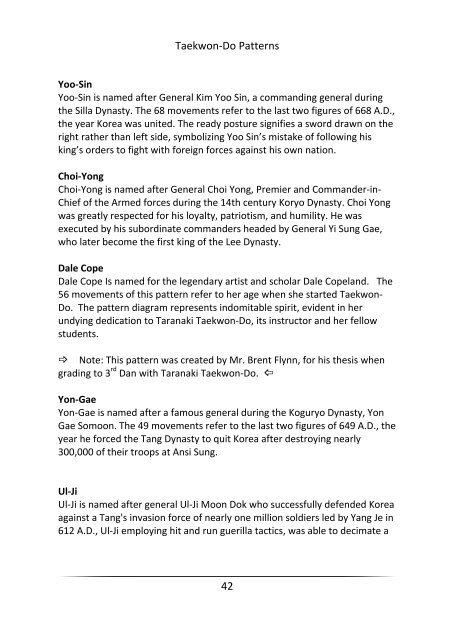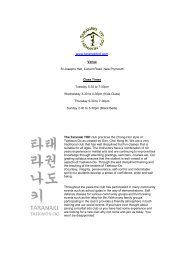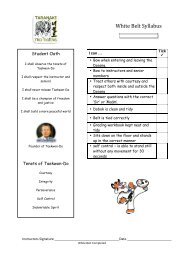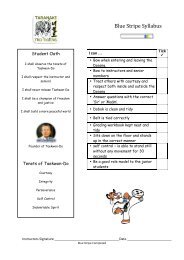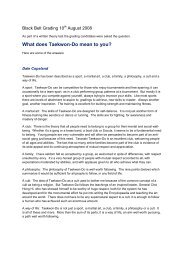Taekwon-Do Patterns (Tul) - Taranaki ITF Taekwondo
Taekwon-Do Patterns (Tul) - Taranaki ITF Taekwondo
Taekwon-Do Patterns (Tul) - Taranaki ITF Taekwondo
Create successful ePaper yourself
Turn your PDF publications into a flip-book with our unique Google optimized e-Paper software.
<strong>Taekwon</strong>‐<strong>Do</strong> <strong>Patterns</strong><br />
Yoo‐Sin<br />
Yoo‐Sin is named after General Kim Yoo Sin, a commanding general during<br />
the Silla Dynasty. The 68 movements refer to the last two figures of 668 A.D.,<br />
the year Korea was united. The ready posture signifies a sword drawn on the<br />
right rather than left side, symbolizing Yoo Sin’s mistake of following his<br />
king’s orders to fight with foreign forces against his own nation.<br />
Choi‐Yong<br />
Choi‐Yong is named after General Choi Yong, Premier and Commander‐in‐<br />
Chief of the Armed forces during the 14th century Koryo Dynasty. Choi Yong<br />
was greatly respected for his loyalty, patriotism, and humility. He was<br />
executed by his subordinate commanders headed by General Yi Sung Gae,<br />
who later become the first king of the Lee Dynasty.<br />
Dale Cope<br />
Dale Cope Is named for the legendary artist and scholar Dale Copeland. The<br />
56 movements of this pattern refer to her age when she started <strong>Taekwon</strong>‐<br />
<strong>Do</strong>. The pattern diagram represents indomitable spirit, evident in her<br />
undying dedication to <strong>Taranaki</strong> <strong>Taekwon</strong>‐<strong>Do</strong>, its instructor and her fellow<br />
students.<br />
� Note: This pattern was created by Mr. Brent Flynn, for his thesis when<br />
grading to 3 rd Dan with <strong>Taranaki</strong> <strong>Taekwon</strong>‐<strong>Do</strong>. �<br />
Yon‐Gae<br />
Yon‐Gae is named after a famous general during the Koguryo Dynasty, Yon<br />
Gae Somoon. The 49 movements refer to the last two figures of 649 A.D., the<br />
year he forced the Tang Dynasty to quit Korea after destroying nearly<br />
300,000 of their troops at Ansi Sung.<br />
Ul‐Ji<br />
Ul‐Ji is named after general Ul‐Ji Moon <strong>Do</strong>k who successfully defended Korea<br />
against a Tang's invasion force of nearly one million soldiers led by Yang Je in<br />
612 A.D., Ul‐Ji employing hit and run guerilla tactics, was able to decimate a<br />
42


